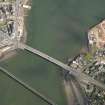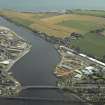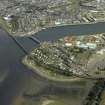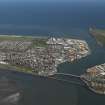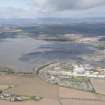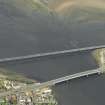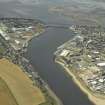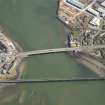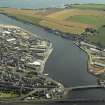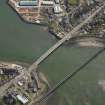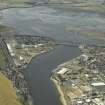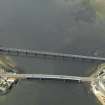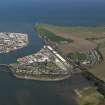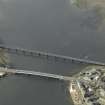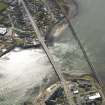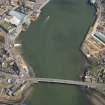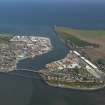Montrose, Bridge
Bridge (18th Century)
Site Name Montrose, Bridge
Classification Bridge (18th Century)
Canmore ID 314950
Site Number NO75NW 590
NGR NO 70991 57225
Datum OSGB36 - NGR
Permalink http://canmore.org.uk/site/314950
- Council Angus
- Parish Montrose
- Former Region Tayside
- Former District Angus
- Former County Angus
Construction (1796)
A traditional knee-braced timber-trestle construction 700 ft long with 13 fixed and one lifting span and considered at the time, because of its magnitude and difficulty of construction, ‘the most remarkable of the kind in the kingdom’. Demolished 1828.
Information from R Paxton and J Shipway 2007b. Reproduced from 'Civil Engineering heritage: Scotland - Highlands and Islands' with kind permission of Thomas Telford Publishers.
Publication Account (2007)
See also NO75NW
The three-span bridge recently constructed by Balfour Beatty Civil Engineering Ltd (2005) will be the fourth bridge to span the river South Esk at this site. The first bridge (1796–1828) was designed by Alexander Stevens and built in partnership with his son Alexander. It was of traditional knee-braced timber-trestle construction 700 ft long with 13 fixed and one lifting span and considered at
the time, because of its magnitude and difficulty of construction, ‘the most remarkable of the kind in the kingdom’. The river varied from between 16 ft and 32 ft deep between low and high water and because of this, and a fast current and a gravelly bottom, great difficulty was experienced in pile-driving.
R Paxton and J Shipway 2007b
Reproduced from 'Civil Engineering heritage: Scotland - Highlands and Islands' with kind permission of Thomas Telford Publishers.
Publication Account (2013)
Road: 1828 suspension bridge by Captain Samuel Brown, his longest span at 432ft. In 1930 Sir E Owen Williams completed a replacement in homage to it: a double cantilever bridge of 216 ft main span constructed in reinforced concrete that echoed the form of the previous suspension bridge. This design led to controversy across the Atlantic: “it is regrettable that a freak structure of inappropriate design should have been allowed to succeed the previous 100-year old suspension bridge” (D B Steinmann). Its successor by Balfour Beatty is again shorter in span than the first bridge (look under the beams for the rounded piers of Brown’s bridge).
Railway: a curving brick arched viaduct crosses the road and Rossie Island leading on to a multispan bowstring girder viaduct on concrete filled piers across the channel. This was built in 1881-3 by Sir Wm Arrol contractors to designs by W R Galbraith
M Watson, 2013
Note (8 July 2014)
Since 1795, there has been a sequence of four road bridges over the River South Esk at the entrance to the Montrose Basin. The earliest documented bridge (NO75NW 607) was built in 1796 and replaced in 1828 by a Suspension Bridge (NO75NW 55.00). This bridge was, in turn, replaced by a concrete bridge (NO75NW 547), designed by Owen Williams, in 1931. Following the discovery of internal decay within the concrete structure, the bridge was closed in 2004 and replaced with a temporary structure whilst a new bridge (NO75NW 607) was being built on the original site.
Information from RCAHMS (PMcK) 8 July 2014





























